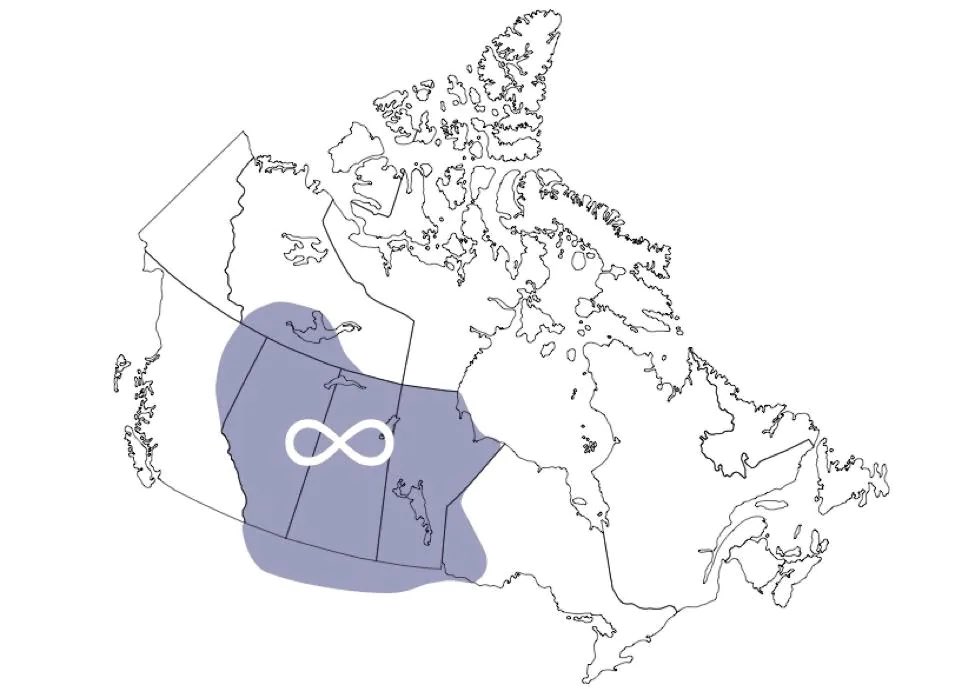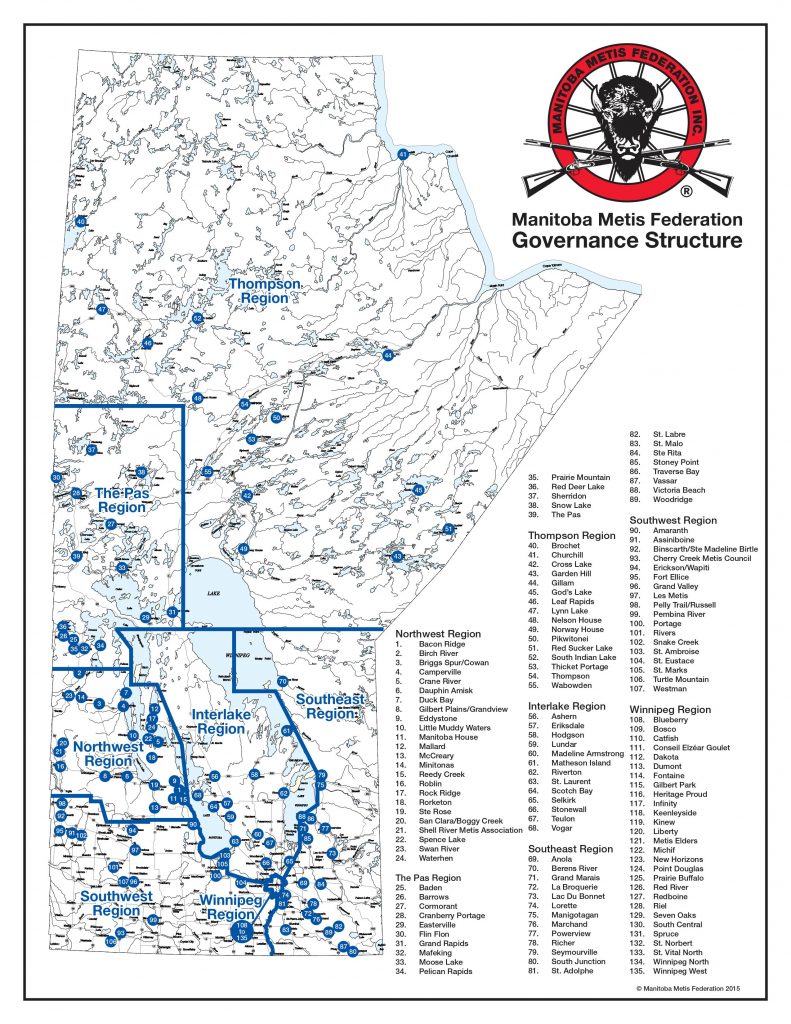Métis
Frequently asked questions about the Métis
Who are the Métis?
The Métis are one of the “aboriginal peoples of Canada” identified in Section 35 of the Constitution Act of 1982. The Métis are people who are Indigenous and do not identify as First Nations or Inuit. The Métis National Council defines “Métis” as a person who “self-identifies as Métis, is distinct from other Indigenous peoples, is of historic Métis Nation Ancestry and who is accepted by the Métis Nation.”
What is the “Métis Nation”?
The Métis Nation comprises contemporary Métis Citizens who self-identify, are accepted by the contemporary Manitoba Métis Community, and descend from the historic Métis Nation–an Indigenous nation from what was formerly known as the Northwest–who rose to defend their people and their Homeland in the early 19th century from invasion. The Métis National Council has represented the Métis Nation on both the national and international stages since 1983. In Manitoba, the Manitoba Métis Federation is the Manitoba Métis Government and represents Manitoba Métis Citizens. Metis Nation Historic Timeline1
What is the “Métis Nation Homeland”?

The Métis Nation Homeland includes the three Prairie Provinces (Manitoba, Saskatchewan, Alberta) as well as parts of Ontario, British Columbia, the Northwest Territories and the Northern United States.
What does it mean to be an “MMF Citizen?”
An MMF Citizen is a person who is registered with the Manitoba Métis Federation’s (MMF) and has gone through the MMF’s ‘objectively verifiable process’ to be registered as a Métis Citizen. As part of this process the applicant must:
- Self-identify as Métis: The application for MMF Citizenship Identification card provides an objective and verifiable way of self-identifying as a Métis. The application process, and the subsequent issuance of cards, protect our Métis rights by preventing non-Métis from wrongly claiming and abusing our self-government and harvesting rights;
- Show an ancestral connection to the Historic Métis Community: In order to objectively verify the ancestral connection to the Historic Métis Nation, applicants in the MMF must submit a copy of their own Métis genealogy, or a family member’s Métis genealogy, and the required supporting evidentiary documents;
- Be accepted by the contemporary Manitoba Métis Community: An objectively verifiable means of showing acceptance by Métis Nation’s Manitoba Métis Community is to have the MMF, as its duly elected self-government representative, issue you an MMF Citizenship2 (also known as membership) card through the application process.
Can anyone who has an Indigenous ancestor be a Métis Citizen?
No.
Self-identification is one of four criteria that each Métis Citizen must meet to register with the Nation. This concept of Métis identity is complicated by those who self-identify as Métis because of their longing to belong to one of the Constitutional Aboriginal groups in Section 35 (1) but cannot claim Indian Status or assert their Inuit ancestry. Many of these individuals believe their mixed ancestry justifies their claim to be Métis. As we have seen in the definition of who is Métis, there are individuals who are not in turn accepted by the Métis Nation because they have no connection to the Historic Métis Nation Homeland and no ancestral ties to the Métis Nation.
This can be hard for people outside of the Métis Nation to understand; however, it is important that there is awareness on this topic. To quote Chris Andersen, a Métis scholar and professor of Native Studies at the University of Alberta who has written at length on this issue:
“I’m Métis because I belong (and claim allegiance) to a set of Métis memories, territories, and leaders who challenged and continue to challenge colonial authorities’ unitary claims to land and society. What’s your excuse for recognizing me – for recognizing us – in any terms other than those of the Métis nationhood produced in these struggles?” (2011)
In September 2002 the Métis Nation adopted the MMF’s Manitoba Metis Federation’s definition of Métis. Article III of the MMF Constitution3 defines “Métis” as follows:
- “Métis” means a person who self-identifies as Métis, is of historic Métis Nation Ancestry, is distinct from other Aboriginal Peoples and is accepted by the Métis Nation;
- “Historic Métis Nation” means the Aboriginal people then known as Métis or Half-Breeds who resided in the Historic Métis Nation Homeland;
- “Historic Métis Nation Homeland” means the area of land in west central North America used and occupied as the traditional territory of the Métis or Half-Breeds as they were then known;
- “Métis Nation” means the Aboriginal people descended from the Historic Métis Nation, which is now comprised of all Métis Nation Citizens and is one of the “aboriginal peoples of Canada” within s.35 of the Constitution Act of 1982;
- “Distinct from other Aboriginal Peoples” means distinct for cultural and nationhood purposes.
What is the Manitoba Métis Federation?
The Manitoba Métis Federation (MMF) is the Manitoba Métis Government. The MMF was created in 1967 to be the democratic and self-governing representative body of the Manitoba Métis Community.
To find out more about the Manitoba Métis Government, visit their website.4

Do Métis people pay taxes?
Métis Citizens are not exempt from paying Provincial Sales Tax (PST) or Goods and Services Tax (GST).
Do Métis people get free post-secondary education?
No. Métis students are not eligible for funding through the federal government’s Post-Secondary Student Support program; only status First Nations and Inuit students are eligible for funding through that program. For the Manitoba Métis, students may be eligible to apply to the Manitoba Métis Federation (MMF) Post-Secondary Education Support Program or to the MMF’s Métis Employment and Training programs for tuition support.
Métis Nation, Culture, Symbols, and Languages
Métis culture is unique and different from First Nations and Inuit cultures. There are several national and cultural symbols that are unique to the Métis Nation.
A well-known national symbol to the Métis Nation is their historic and national flag. Referred to frequently as the ‘infinity flag’ it has a blue background with a white infinity symbol and reflects the joining of two cultures and the existence of a people forever. It was recorded that the flag was flown for the first time in 1816 at the Battle of Frog Plains in Red River (present day Winnipeg) and has since been used as the national flag of the Métis Nation.
The sash is recognized as a part of Métis culture. Historically, it was part of the clothing worn by Métis people (predominantly men) every day for both fashion and function. It had many uses such as a holder, washcloth, bridle or saddle blanket. In contemporary times, the sash is worn by Métis people today (men, women, and non-binary) in celebration of their culture and identity. It can be worn on one’s waist just above the hip or across one’s shoulder.
Historically, Métis traditional styles were a distinctive blend of European and First Nation styles and traditions. Clothing and other garments were made with leather, wool, and cotton textiles. Clothing, garments, and other items such as horse saddles, dog tuppies, and interior household items would often be adorned with beautiful floral embroidery, quillwork, pompoms and, of course, distinct floral Métis-styled beadwork. The adornments on these items were distinctively Métis and were a symbol of identity, pride, and their spirits–a people with a passion for a joyful life. Their style was so distinctive, they were recognized as ‘the flower beadwork people’ of the plains.
Following the Reign of Terror5 on the heels of the Red River Resistance in 1869-1870, many Métis hid their identifiable garments and stopped their artistic traditions for fear of their lives and the lives of their families. Today, however, many Métis have reclaimed their artistic traditions and new artists are emerging to bring back to life old-style Métis beadwork, embroidery, and quillwork in both historic and contemporary fashions.
The Métis people are a spirited people, who have always had a love of music and dance. They are renowned worldwide for their unique fiddle music that compliments their distinctive high energy dance known as ‘the jig’ or ‘the red river jig’. The main musical instrument of the Métis is the fiddle, which the Métis traditionally made from maple wood and birch bark. Unlike other styles of music, the Métis style of fiddle music is not contained in a bar structure. As a result, there is ‘a bounce’ to the tune that is unique to the Métis-style. This is not a trained style, but rather has been passed down from generation to generation. This type of music style lends itself to the jig6–which is a unique dance of the Métis that pulls from Scottish, Irish, French, and First Nation dance traditions.
Métis Languages
The Michif language is a distinct language to the Métis Nation. Michif, (also referred to as Southern Michif or Heritage Michif) has grammatical and lexical features of Indigenous languages (Cree, and Saulteaux) and Michif-French (a Prairie-French dialect of the French language). The Michif language is a very unique language among languages around the globe, as no other languages show mixed nouns from one language and verbs from another in the manner that Michif does. Unfortunately, as a result of colonization, the Michif Language is critically endangered with very few speakers left. The Métis Nation is currently working with their governments, communities, and language revitalization experts to bring the Michif language back into use and increase the number of fluent speakers.
The Métis are a polylingual Nation, meaning that many people and families within the Nation spoke multiple languages, including both Indigenous and European languages. Due to their high mobility across the Métis Nation Homeland, their kinship relations, and their social, economic, and political relations many Métis also spoke (and still do) Cree, Dene, Saulteaux, and Michif-French.
Métis spirituality
A common misconception is that the Métis practiced only the religion of their European ancestors (Catholic or Protestant). However, the reality is that people and families within the Métis Nation have varying experiences with religious affiliation and spirituality. Like any Indigenous Nation, some people and families have fluid, rigid, simple, or complex spiritual practices and affiliations from both their Indigenous or European ancestors’ traditions.
Media Attributions
‘Métis Nation Homeland’ (Métis National Council), provided by the Louis Riel Institute, is licensed under an All Rights Reserved License. It is not subject to the Creative Commons license and may not be reproduced without the prior and express written consent of the Métis National Council.
‘MMF Locals’ (Manitoba Métis Federation) is licensed under an All Rights Reserved License. It is not subject to the Creative Commons license and may not be reproduced without the prior and express written consent of the Manitoba Métis Federation.
Notes
- Métis Nation Historic Timeline (https://www.metisnation.ca/what-we-do/cfs/chronology)
- Métis Citizenship (http://www.mmf.mb.ca/citizenship-application-faqs)
- MMF Constitution (https://www.mmf.mb.ca/wcm-docs/freetext/mmf_constitution_2022_20220805131732.pdf)
- Manitoba Métis Federation (https://www.manitobametis.com/)
- Reign of Terror (http://www.metismuseum.ca/resource.php/149078)
- Red River Jig (http://www.metismuseum.ca/resource.php/14602)

